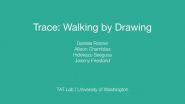Non-Euclidean geometries for grid cells
Can the brain map 'non-conventional' geometries (and abstract spaces)?
2015-05-07
(Press-News.org) "It took human culture millennia to arrive at a mathematical formulation of non-Euclidean spaces", comments SISSA neuroscientist Alessandro Treves, "but it's very likely that our brains could get there long before. In fact, it's likely that the brain of rodents gets there very naturally every day".
Treves coordinated a study just published in the journal Interface. Euclidean geometry is the kind of geometry we normally study at school, whereas non-Euclidean geometries are all those that reject one or more of Euclid's five postulates. A geometry that unfolds on a curved surface is an example. Recent research has investigated how the brain encodes flat spaces. In 2005, Edvard and May-Britt Moser discovered grid cells, neurons of the entorhinal cortex of rodents that fire in a characteristic way when the animal moves in an arena. The discovery has recently been awarded the Nobel Prize, but all experiments conducted to date have involved flat (Euclidean) surfaces. So what happens with other types of surface?
The starting point is the formation of these brain "maps". "There are two main classes of theoretical models that attempt to explain it, but both of them assume that our brain contains some kind of "engineer" that has prepared things appropriately" says Treves. "These models take for granted that the system originates with substantial prior knowledge, and they closely reproduce the behaviour of the biological system under known conditions, since they are constructed precisely on its observation. But what happens in conditions that have yet to be explored experimentally? Are these models able to 'generalize', that is, to make a genuine prediction to be then confirmed by other experiments? A correct theory should tell us more than what we already know".
Treves and colleagues have been developing a new, radically different model since 2005, and in their recent paper they have indeed attempted a broad generalization. "Ours is a self-organizing model, which simulates the behaviour of 'artificial' grid cells capable of learning by exploring the environment".
More in detail
The model is based on mathematical rules and its final characteristics are determined by the environment in which it "learns from experience". In previous studies, the model was tested on flat surfaces: "in these settings our artificial grid cell shows the same hexagonal symmetrical firing pattern seen in biological cells".
"To apply it to a new situation, we thought of having our model move in a non-Euclidean space, and we chose the simplest setting: a space with a constant curvature, in other words a sphere or pseudosphere". The recently published study shows the results achieved with the pseudospherical surface, which demonstrate that in this case the firing pattern has a heptagonal, seven-point, symmetry. This finding can now easily be compared with the firing of real grid cells, in rodents raised on a pseudospherical surface. "We're waiting for the experimental results of our Nobel Prize-winning colleagues from Trondheim" explains Treves. "If our results are confirmed, then new theoretical considerations will ensue that will open up new lines of research".
In addition to demonstrating that maps adapt to the environment in which the individual develops (and so are not genetically predetermined), the observation of a heptagonal symmetry in new experimental conditions - which would show that the brain is able to encode a non-Euclidean space - would also suggest that grid cells might play a role in mapping many other types of space, "including abstract spaces", adds Treves. "Try to imagine what we might define as the space of movements, or the space of the different expressions of the human face, or shapes of a specific object, like a car: these are continuous spaces that could be mapped by cells that are not the same but are similar to grid cells, cells that could somehow represent the graph paper on which to measure these spaces".
INFORMATION:
In addition to Treves, participants in the research included Eugenio Urdapilleta (first author), Francesca Troiani and Federico Stella. A note of colour: the research has already attracted the attention of the editors of "Improbable Research", the journal that awards the IgNobel prizes, deserving a mention on their website: http://goo.gl/e1evbV .
USEFUL INFO:
A copy of the original paper can be requested by journalists writing to the press office.
ELSE PRESS RELEASES FROM THIS DATE:
2015-05-07
New developments in personalised and precision medicine (PPM) could offer enormous gains in healthy life expectancy for Americans, but the incentives to develop them are weak, according to Dr Victor Dzau, President of the US Institute of Medicine, and colleagues [1], writing in a Personal View in The Lancet.
PPM tailors medical treatment to the individual characteristics of each patient, according to their susceptibility to a particular illness. But PPM goes beyond just targeting therapies at individuals who are ill; it includes the ability to identify those at highest ...
2015-05-07
PROVIDENCE, R.I. [Brown University] -- Surveys of loved ones who lost elderly relatives show that the perception of the quality of care for the dying in the United States has worsened over the last decade. For all the health care industry has done to try to make progress, huge gaps remain between how care is delivered and what patients and their loved ones want, reports a new study in the Journal of Palliative Medicine.
"People are less satisfied with care at the close of life, and I think it's now urgent for us to start thinking about what interventions we can do to ...
2015-05-06
DALLAS, May 6, 2015 -- People with hemorrhagic strokes (brain bleeds) are more likely to survive if they are treated at a comprehensive stroke center, according to research published in the Journal of the American Heart Association.
Hemorrhagic strokes, which account for about 13 percent of all strokes, are caused when a weakened blood vessel in the brain ruptures and bleeds in the surrounding brain. Comprehensive stroke centers typically have the specialists and trained personnel to deal with patients with these ruptures or other types of bleeding in the brain. They ...
2015-05-06
Insurance coverage has increased across all types of insurance since the major provisions of the federal Affordable Care Act took effect, with a total of 16.9 million people becoming newly enrolled through February 2015, according to a new RAND Corporation study.
Researchers estimate that from September 2013 to February 2015, 22.8 million Americans became newly insured and 5.9 million lost coverage, for a net of 16.9 million newly insured Americans.
Among those newly gaining coverage, 9.6 million people enrolled in employer-sponsored health plans, followed by Medicaid ...
2015-05-06
Psychologists are to improve online health information on lung cancer after research showed that family members are more likely to search online to encourage loved ones to seek help.
This is one of the outcomes from research by PhD student Julia Mueller based in the School of Nursing, Midwifery and Social Work at The University of Manchester (part of the Manchester Cancer Research Centre) who will present her study today, Thursday 7 May 2015, at the Annual Conference of the British Psychology Society being held in Liverpool.
Julia Mueller said: "People displaying ...
2015-05-06
The ulcer-causing bacterium Helicobacter pylori can directly interact with stomach stem cells, causing the cells to divide more rapidly, according to a new study by researchers at the Stanford University School of Medicine.
The increased cell division was observed in mice, but the findings could explain why H. pylori is a risk factor for gastric cancer in humans, the researchers said.
They used 3-D microscopy to identified colonies of the bacteria deep within human stomach glands, where stem cells and precursor cells that replenish the stomach's lining reside.
One ...
2015-05-06
MADISON, Wis. -- The suspicion that the federal Affordable Care Act reduces options for patients to choose their health care providers proves to be true, according to a new study co-authored by David Weimer, a professor with the La Follette School of Public Affairs at the University of Wisconsin-Madison. However, the quality of hospitals in insurance exchange networks was as good or better than those in commercial insurance networks.
The study, just published in the May issue of the journal Health Affairs, compared the hospital networks available to California consumers ...
2015-05-06
Creative athletes have been using geographic information systems to transform their running routes into kangaroos, robots and other works of art that they share online, and one romantic cyclist last year even spelled out "Will you marry me, Emily?" with his bike.
A new mobile app developed at the University of Washington does the opposite. The Trace app turns a digital sketch that you draw on your smartphone screen -- a heart, maple leaf, raindrop, sailboat -- into a walking route that you can send to a friend or loved one. The recipient of the "gift" tells the app how ...
2015-05-06
Scientists at the National Institutes of Health have solved a long-standing mystery about the origin of one of the cell types that make up the ovary. The team also discovered how ovarian cells share information during development of an ovarian follicle, which holds the maturing egg. Researchers believe this new information on basic ovarian biology will help them better understand the cause of ovarian disorders, such as premature ovarian failure and polycystic ovarian syndrome, conditions that both result in hormone imbalances and infertility in women.
Researchers at the ...
2015-05-06
The Alaska salmon fishery is touted as one of the best in the world. When measured with an ecological yardstick, it is - fish stocks are healthy and the fishery is certified by the Marine Stewardship Council as consistently meeting rigorous biological standards. Fish are individually counted as they swim upstream to ensure there are enough to breed.
But Alaska salmon falls short and lags behind some of the world's fisheries in how it benefits local fishermen, processing workers and nearby rural communities, according to a new assessment that ranks the vitality of a fishery ...
LAST 30 PRESS RELEASES:
[Press-News.org] Non-Euclidean geometries for grid cells
Can the brain map 'non-conventional' geometries (and abstract spaces)?

